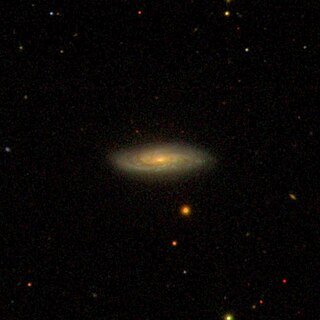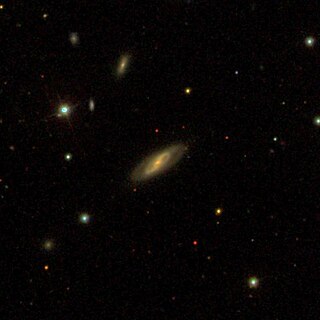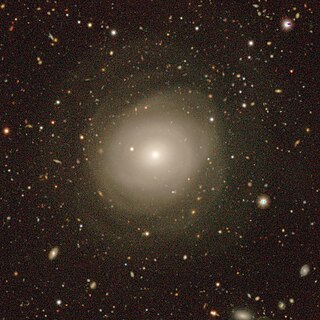
The New General Catalogue of Nebulae and Clusters of Stars is an astronomical catalogue of deep-sky objects compiled by John Louis Emil Dreyer in 1888. The NGC contains 7,840 objects, including galaxies, star clusters and emission nebulae. Dreyer published two supplements to the NGC in 1895 and 1908, known as the Index Catalogues, describing a further 5,386 astronomical objects. Thousands of these objects are best known by their NGC or IC numbers, which remain in widespread use.

NGC 188 is an open cluster in the constellation Cepheus. It was discovered by John Herschel in 1825. Unlike most open clusters that drift apart after a few million years because of the gravitational interaction of our Milky Way galaxy, NGC 188 lies far above the plane of the galaxy and is one of the most ancient of open clusters known, at approximately 6.8 billion years old.

NGC 246 is a planetary nebula in the constellation Cetus. It is the first known planetary nebula to have a hierarchical triple star system at its center. The nebula and the stars associated with it are listed in several catalogs, as summarized by the SIMBAD database. NGC 246 was discovered by William Herschel in 1785.

NGC 16 is a lenticular galaxy located in the Pegasus constellation. It was discovered on September 8, 1784, by William Herschel.

NGC 22 is a spiral galaxy located in the Pegasus constellation. It was discovered in 1883 by Édouard Stephan.

NGC 7008, also known as the Fetus Nebula is a planetary nebula with a diameter of approximately 1 light-year located at a distance of 2800 light years in northern Cygnus. It was discovered by William Herschel in 1787, in Slough, England. NGC 7008 is included in the Astronomical League's Herschel 400 observing program.NGC 7008 is that its intricate and delicate structures make it a fascinating target for both amateur and professional astronomers studying the late stages of stellar evolution and the formation of planetary nebulae.

"Legacy Survey Sky Browser". www.legacysurvey.org. Retrieved 2023-05-19.

NGC 51 is a lenticular galaxy in the constellation Andromeda. It has a diameter of 90,000 light-years. The galaxy was discovered on September 7, 1885, by Lewis Swift, who described it as "Pretty faint, pretty small, round, brighter middle."

NGC 54 is an edge-on spiral galaxy in the constellation of Cetus. The galaxy was discovered by Wilhelm Tempel in 1886, and he defined it as "very faint, pretty small, round." The galaxy is 90,000 light years in diameter, making it slightly smaller than the Milky Way.

NGC 61 is a pair of lenticular galaxies, NGC 61-A and NGC 61-B in the constellation Cetus. Both were discovered on September 10, 1785, by William Herschel.

NGC 72 is a barred spiral galaxy estimated to be about 320 million light-years away in the constellation of Andromeda. It was discovered by R. J. Mitchell in 1855 and its magnitude is 13.5.

NGC 74 is a lenticular galaxy located in the Andromeda constellation. It was discovered on 7 October 1855 by Irish astronomer William Parsons.

NGC 523, also known as Arp 158, from the ARP catalog is a spiral galaxy located in the constellation Andromeda. It was discovered separately by William Herschel on 13 September 1784, and by Heinrich d'Arrest on 13 August 1862. d'Arrest's discovery was listed as NGC 523, while Herschel's was listed as NGC 537; the two are one and the same. John Dreyer noted in the New General Catalogue that NGC 523 is a double nebula.

NGC 466 is a lenticular galaxy located about 227 million light-years away from Earth in the constellation Tucana. NGC 466 was discovered by astronomer John Herschel on October 3, 1836.

NGC 480 is a spiral galaxy located about 546 million light-years away from Earth in the constellation Cetus. NGC 480 was discovered by American astronomer Francis Leavenworth In 1886.

NGC 468 is a spiral galaxy in the constellation Pisces. Located approximately 209 million light-years from Earth, it was discovered by John Frederick William Herschel in 1827.

NGC 4466 is an edge-on spiral galaxy located about 50 million light-years away in the constellation of Virgo. NGC 4466 was discovered by astronomer Bindon Stoney on February 26, 1851. The galaxy is a member of the Virgo Cluster.

NGC 6453 is a globular cluster approximately 37,000 light-years away from Earth in the constellation of Scorpius.

NGC 906 is a barred spiral galaxy in the constellation Andromeda in the northern sky. It is estimated to be 215 million light years from the Milky Way and has a diameter of approximately 110,000 ly. NGC 906 was discovered on October 30, 1878 by astronomer Édouard Stephan.


















